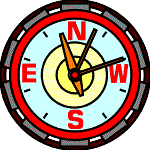WHERE IN THE WORLD IS THE BERMUDA
TRIANGLE?

SHORT TERM GOALS:
- To introduce students to the mysterious location in the ocean
known as the Bermuda Triangle.
- To help students become familiar with map skills such as
longitude and latitude when locating places on a map.
- To help students become familiar with finding areas and
distances using map scales and mathematical formulas.
TIME ALLOTMENT: 2 hours
CONTENT AREAS ADDRESSED:
(1) Science
(2) Math
(3) Language Arts
(4) Geography
CONCEPTS ADDRESSED:
- Map Skills
- Area
- Distance
- Volume
- Triangle shape formulas
MATERIALS:
- Atlases
- Several World Maps (Different Types)
- Rulers
- Pencil and Paper
PROCEDURE:
Just as The Odyssey has many mysterious places, Earth also
has some mysterious places. One of these places is known as the
Bermuda Triangle. This area in the ocean has been a topic of concern
and interest for many years. The students are going to have the
opportunity to become familiar with this area and the possible
theories for disappearances throughout the next few lessons.
- The Bermuda Triangle is a mysterious location in the Atlantic
Ocean between the points of Miami, Bermuda, and Puerto Rico. In
this area several disappearances of planes and ships have been
reported. Ask the students if they have ever heard of any of the
disappearances or myths of the Bermuda Triangle before going in
depth with this area and its disappearances. Explain to them that
locating this area on a map is extremely important for travelers
and other people who may not know the exact location of this area
or any area on a map. One way to locate places on a map is by
using a grid system for the earth, which is divided into degrees,
minutes, and seconds.
- Begin showing the students lines of latitude and longitude on
a map—at this time, the students should also have maps in
front of them so they can follow along.
- Ask the students if they know what the zero degree line of
latitude is called, as well as the zero degree line of longitude.
Once the students have found these locations, they can begin
locating other locations, such as their state or a favorite city.
- The students can then locate the three vertices of the Bermuda
Triangle. (Miami, Puerto Rico, and Bermuda)
- Using the scales on the map (after explaining what a scale
is), the students can use these scales to determine the distance
between the three vertices of the triangle. This will help with
defining the perimeter of the triangle.
- Perimeter may be somewhat of an easy task for the students,
but the area is what most scientists and researchers are concerned
about with the Bermuda Triangle. The students can find the area of
the Bermuda Triangle by knowing the base and height of the
triangle. Keep track of all the responses and compare the
differences between all the different maps. (The students will all
be using different maps, but the measurement results should be
similar.)
- Students will have a chance to look through other resources
such as atlases and maps so they can compare their measurements
with those of their peers. Students will also compare the
locations of the vertices on each map. The students will be
perfecting their map reading skills at the same time as learning
about the Bermuda Triangle.
- Once the students have found their areas and perimeters, they
will have the ability to locate any cities on a map, do more
extensive map work, and even use their given measurements to find
the volume of the triangle. The volume will be able to be found
only if the depth of water can be determined somehow.
This lesson was adapted from:
Gilbert, L. (1998). Map skills. Grand Rapids, MI:
Instructional Fair. [ISBN: 1-56822-641-1]
ASSESSMENT:
- Bermuda Map Skills Rubric
- Observation Checklist
EXTENSIONS:
- Allow the students to go much more in depth with the Bermuda
Triangle- asking the students about miles per hour, etc. How much
time would the students expect to take to travel between points at
60 mph, 30 mph, etc?
- Video on the Bermuda Triangle (Found in the Resources)
- Introduce the students to three different types of maps,
including topographic, political, and physical maps. Allow the
students to compare and contrast each of the maps.
RESOURCES:
Baker, W. & Haslam, A. (1992). Make it work: Earth. New
York: Thomson Learning. [ISBN: 1-56847-468-7]
The Bermuda Triangle: Uncovering the mystery of a watery
graveyard. (1976). NOVA- Vestron Video. [ISBN: 0-8051-0587-5]
Gilbert, L. (1998). Map skills. Grand Rapids, MI:
Instructional Fair. [ISBN: 1-56822-641-1]
Go to:
Using Sonar to map the Ocean Floor and
Find Sea Monsters lesson
Exploring the Disappearances of the
Bermuda Triangle lesson
Table of Contents
St. Norbert College Ocean
Voyager's page

